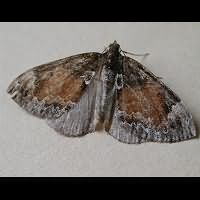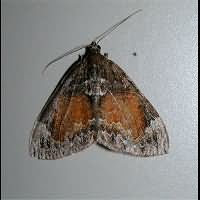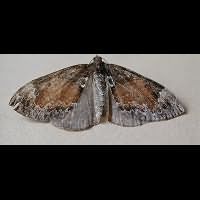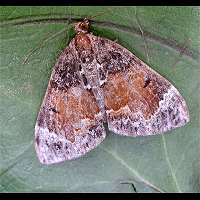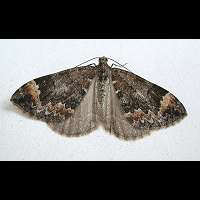Common Marbled Carpet (Chloroclysta truncata)
At first sight the Common Marbled Carpet often seems to look completely worn out, even though well marked animals do fly about, like the one in the third picture. Still this species is hard to identify at times, for there exist two very similar species: the Dark Marbled Carpet and the Arran Carpet. The difference between the Dark Marbled Carpet and the Common Marbled Carpet is best seen in the lines on the underside of the wing. The line in the middle of both upperwing and underwing are wavy in the Common species and hooked in the Dark Marble Carpet. The same happens on the upper side of the front wings: the lines are more wavy in the Common and more hooked in the dark, but the difference is often very hard to tell and both species are extremely variable. The white lines on the upperside of the wing of the Arran Carpet are often interrupted and sometimes blotched. However darkened animals of both species are often very hard to tell apart. The Common Marbled Carpet is common all over Britain, the Dark Marbled Carpet is fairly common and the Arran Carpet is scarce, living in parts of Scotland only, and is sometimes considered to be a mere form of the Common Marbled Carpet and not a separate species.
The eggs that have been laid by moths of the second generation hatch in August. The larvae start eating immediately, but they grow slowly. In September they'll stop eating and go into hibernation. In March or April they'll start eating again and will pupate between leaves spun together in May. Pupation takes a short while only and the first Moths of the new generation will appear in May. These mainly deposit their eggs in June. The resulting caterpillars grow incredibly fast and may even pupate within three weeks. The caterpillar is green, and has yellow bands between the segments. Usually purple or blackish short lines on the side, even though these may merge in one small line running all over the body. At the end of the body are two strikingly blackish dots. The head is dark. The larvae of the Common Marbled Carpet remain small all their lives, for their length usually is some 20 to 24 mm only. They may be found on trees like Birch and Willow, shrubs like Hawthorn and Heath and lower plants such as Blueberry and wild Strawberry. The Common Marbled Carpet flies in two clearly separated generations a year. The first generation flies in June mainly, even though some individuals may be seen as early as April. The second generation is on the wing in August and September, even though sometimes seen in October or even the beginning of November. It is easily disturbed during the day, but will fly by night only. It is easily attracted to light, but never in great numbers. This is a species of forests and woodlands, hedgerows, parks and gardens. Common all over the British Isles. In parts of Scotland, especially at higher altitudes only one generation is on the wing in July and August. Also a very common species on the continent, where it is double-brooded as well, except for mountain areas and much of Scandinavia, where it is single-brooded like in Scotland.
At first sight the Common Marbled Carpet often seems to look completely worn out, even though well marked animals do fly about, like the one in the third picture. Still this species is hard to identify at times, for there exist two very similar species: the Dark Marbled Carpet and the Arran Carpet. The difference between the Dark Marbled Carpet and the Common Marbled Carpet is best seen in the lines on the underside of the wing. The line in the middle of both upperwing and underwing are wavy in the Common species and hooked in the Dark Marble Carpet. The same happens on the upper side of the front wings: the lines are more wavy in the Common and more hooked in the dark, but the difference is often very hard to tell and both species are extremely variable. The white lines on the upperside of the wing of the Arran Carpet are often interrupted and sometimes blotched. However darkened animals of both species are often very hard to tell apart. The Common Marbled Carpet is common all over Britain, the Dark Marbled Carpet is fairly common and the Arran Carpet is scarce, living in parts of Scotland only, and is sometimes considered to be a mere form of the Common Marbled Carpet and not a separate species.
The eggs that have been laid by moths of the second generation hatch in August. The larvae start eating immediately, but they grow slowly. In September they'll stop eating and go into hibernation. In March or April they'll start eating again and will pupate between leaves spun together in May. Pupation takes a short while only and the first Moths of the new generation will appear in May. These mainly deposit their eggs in June. The resulting caterpillars grow incredibly fast and may even pupate within three weeks. The caterpillar is green, and has yellow bands between the segments. Usually purple or blackish short lines on the side, even though these may merge in one small line running all over the body. At the end of the body are two strikingly blackish dots. The head is dark. The larvae of the Common Marbled Carpet remain small all their lives, for their length usually is some 20 to 24 mm only. They may be found on trees like Birch and Willow, shrubs like Hawthorn and Heath and lower plants such as Blueberry and wild Strawberry. The Common Marbled Carpet flies in two clearly separated generations a year. The first generation flies in June mainly, even though some individuals may be seen as early as April. The second generation is on the wing in August and September, even though sometimes seen in October or even the beginning of November. It is easily disturbed during the day, but will fly by night only. It is easily attracted to light, but never in great numbers. This is a species of forests and woodlands, hedgerows, parks and gardens. Common all over the British Isles. In parts of Scotland, especially at higher altitudes only one generation is on the wing in July and August. Also a very common species on the continent, where it is double-brooded as well, except for mountain areas and much of Scandinavia, where it is single-brooded like in Scotland.

